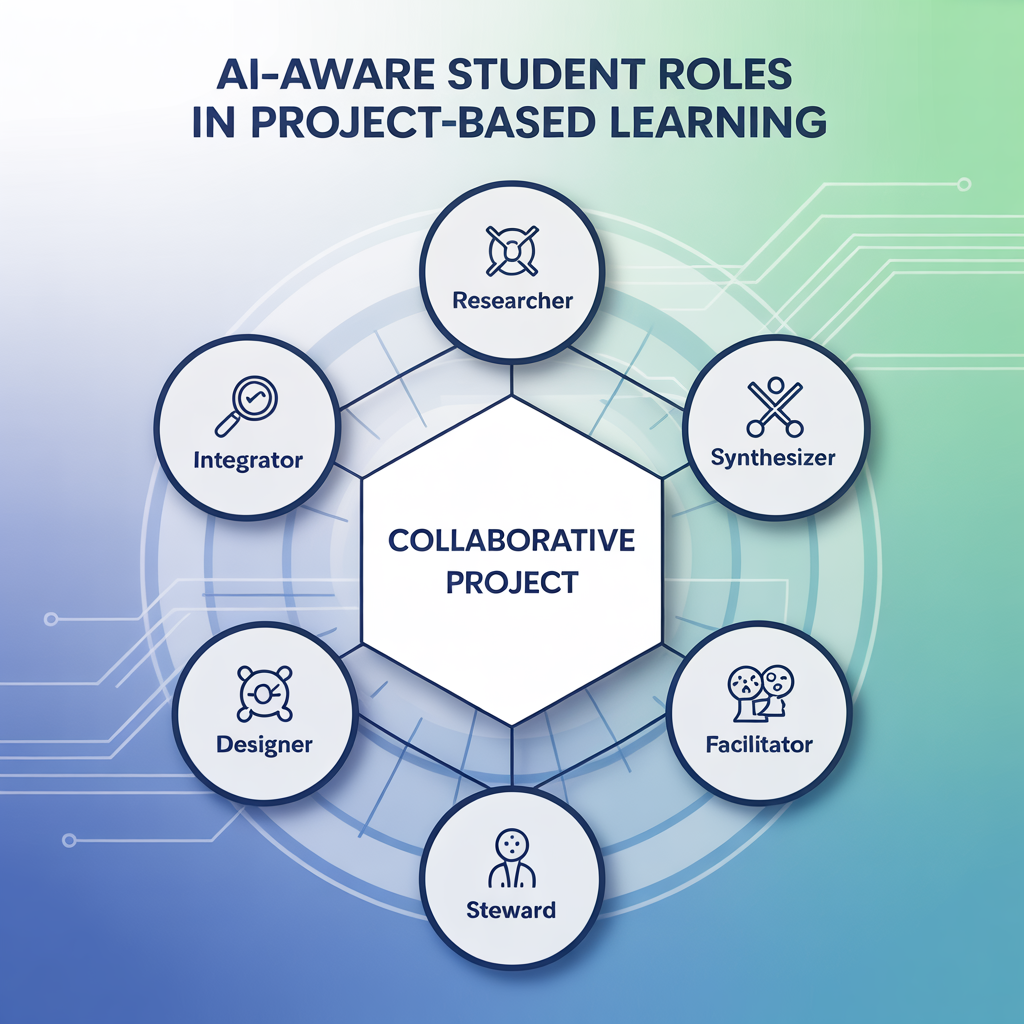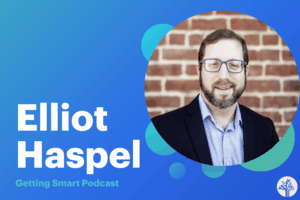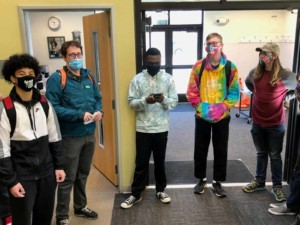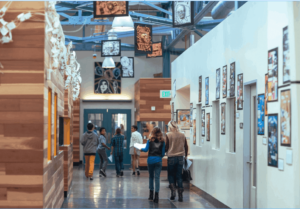AI-Aware Roles for PBL Collaborative Work
Key Points
-
Redefining group roles in project-based learning can integrate AI tools to enhance collaboration, ethical reflection, and media literacy.
-
AI-aware roles help students evaluate, creatively use, and ethically reflect on AI tools, preparing them for future challenges.

If my tombstone ever gets a subtitle, it will read: ‘Loving husband. Devoted father. PBL fanatic.’
It’s been the story of my 30+ years in education, which extends from 12 years as a classroom teacher to CEO of the Partnership for 21st Century Learning. I’ve focused on developing policy, research, and best practices for the implementation of project-based learning.
My writing and consulting on educational uses of generative AI have not dimmed my devotion to PBL, with evidence provided by the brand name that marks my work across all major social media platforms (@DavidPBLRoss).
Recently, I have turned my attention to the need to redefine the roles teachers use to structure group work in projects. What you read here is an attempt to provide new or adapted definitions of the roles students assume while participating in a project in an AI-aware classroom.
AI-Aware Roles
I am not going to debate the merits of using designated roles for group work for PBL. Multiple researchers have provided ample evidence of the importance of group work and related roles, with Elizabeth Cohen’s Designing Groupwork: Strategies for the Heterogeneous Classroom shining brightly as my North Star.
Upon extended reflection, reading, and insight provided by deep research across multiple AI platforms, I have formulated the following typology for AI-aware roles in groupwork. This list functions effectively for any group size, but in practice, you’ll choose only the roles that fit your learning outcomes and product requirements.

1. AI Integrator & Evaluator
- Designs and refines prompts to generate ideas, prototypes, explanations, or data.
- Reviews AI outputs for accuracy, relevance, and bias, ensuring ethical use and proper attribution.
2. Researcher & Fact-Checker
- Validates AI-generated and human-sourced content using trusted references.
- Identifies gaps, contradictions, and bias, reinforcing digital literacy.
3. Synthesizer & Knowledge Curator
- Blends AI outputs with student research and ideas into a coherent narrative or product.
- Ensures logical flow, meaningful integration, and fidelity to the project’s purpose.
4. Creative Designer & Product Developer
- Uses AI-assisted drafts to design final deliverables — visual, written, or multimedia — while prioritizing human-centered creativity.
5. Ethics & Impact Steward
- Guides discussions on AI’s ethical implications, including bias, representation (i.e., Are diverse groups portrayed accurately and respectfully?), and privacy.
- Monitors AI use for fairness and respect, and documents ethical decisions.
6. Facilitator & Communicator
- Keeps the team organized, manages workflow, and ensures equitable participation.
- Coordinates presentation of the group’s work, explaining the process and AI’s contributions.
Would you use all of these roles in a project? Of course not. But you could sample this typology and select roles that are relevant to your learning outcomes and the student work products being generated. I would advise that you consider maintaining core roles like Facilitator and Ethics Steward static for consistency across all projects.
The California Missions Project – Revised
Any of the tens of thousands of teachers who have sat in on my professional development sessions can vouch for the fact that the instructional task I spend the most time haranguing is the California Missions Project, a rite of passage for all fourth-graders in my state.
My tireless rant is a major reason why I am revising the design of this project to include roles and student work products relevant to the AI-aware classroom.
As always, let’s begin with a Driving Question: “How can we tell the story of a California mission in a way that honors its history, acknowledges its impacts on Native peoples, and uses AI tools responsibly to deepen understanding?”
Project Outcomes:
From the California History and Social Science Standards:
- Describe the historical significance of their assigned mission, including its founding, architecture, and role in California’s development.
- Explain the impact of the missions on Native peoples, including cultural, social, and economic effects.
- Identify and use primary and secondary sources to construct a historically accurate narrative.
- Create an accurate visual or model of their mission that reflects verified historical details.
- Synthesize historical information into a coherent, engaging written report and oral presentation.
AI and Media Literacy Outcomes:
By the end of the project, students will be able to:
- Formulate effective AI prompts to gather relevant historical, visual, and cultural information.
- Evaluate AI-generated outputs for accuracy, relevance, bias, and completeness.
- Cross-check AI outputs with credible, human-authored sources to confirm accuracy.
- Identify bias and perspective in both AI-generated and human-created historical accounts.
- Document AI usage transparently, including prompts, outputs, and verification steps.
- Reflect on the ethical implications of using AI in historical research, especially when representing marginalized groups.
- Use AI-generated materials creatively but responsibly, ensuring they supplement—not replace—student thinking and originality.
21st Century Learning Outcomes:
By the end of the project, students will be able to:
- Work interdependently in assigned roles, contributing unique expertise to the group’s success.
- Communicate effectively within the group, resolving conflicts and making decisions collaboratively.
- Manage project timelines and responsibilities, ensuring each milestone is met.
- Engage in structured inquiry, asking deep, open-ended questions and pursuing evidence-based answers.
- Present findings to an audience clearly, confidently, and with visual support that aligns to their narrative.
Among the outcomes for this project you will notice a focus on students not just consuming AI outputs; they are evaluating, editing, and reflecting on them. Extended outcomes target AI/media literacy, bias awareness, and ethical reflection. This list aligns with a variety of AI literacy frameworks, including AI4K12’s “Five Big Ideas,” TeachAI Literacy Framework from OECD, Digital Promise AI Literacy Framework, MIT Media Lab’s Impact.AI: K-12 AI Literacy, the ISTE Standards for Students, and the Digital Education Council AI Literacy Framework.
(Note: If you are wondering how I would assess this project you can take this link to a Google doc that has my draft rubric.)
Student work products:
- Written report that blends AI-assisted research with student-generated analysis
- Interactive presentation that uses AI-generated visuals/maps alongside primary sources
- Replica/model of the mission (physical or 3D digital), informed by historical accuracy checks
- Ethics reflection documenting how AI was used and evaluated
Student roles:
For this project I’ve used my preferred group size of four:
- AI Integrator & Evaluator
- Researcher and Fact Checker
- Creative Designer and Product Developer
- Ethics and Impact Steward
Keep in mind that the roles demand interdependence — no single student can complete the whole project without contributions from the others. As a wise man once said, you can’t collaborate by yourself.
AI and Group Work
Over the last couple of years I have argued extensively that AI forces us to redefine important student outcomes, among them the four Cs: Creativity, Collaboration, Critical Thinking, and Communication. Redefinitions should include specific recommendations on how to develop these skills within the context of rigorous, relevant, and engaging projects.
Educators must acknowledge the fact that students will be using AI (in the classroom or at home, regardless of age restrictions) to complete their work. PBL, which functions best when implemented via collaborative work, has to take advantage of what generative AI offers us to restructure the roles and duties of students working in groups.






0 Comments
Leave a Comment
Your email address will not be published. All fields are required.